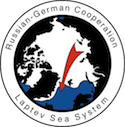 Task 4A
Task 4A
Dynamics of pelagic particle processes and benthic functional diversity patterns (TRANSDRIFT XXIV + XXV)
This task will focus on functional aspects in the ongoing and future marine ecosystem alter¬a-tions in the Laptev Sea and adjacent regions in response to climate change. Speci¬fi¬cal¬ly, the task team will investigate A1) dynamics of particulate organic matter and A2) particle trans-port processes in the water column, with a focus at the northwestern Laptev shelf break, and A3) benthic spatial diversity patterns and their link to community structure and eco¬system functioning. With this research, three interrelated research objectives will be address¬ed: A1) to understand the influence of strong seasonal perturbations, caused by riverine inflow of freshwater and organic matter, on shelf-break plankton dynamics and particle flu¬xes, as well as processes within seasonal sea ice, A2) to determine the impact of changing climatic conditions (e.g., less sea-ice cover and wind-driven mixing) on the particle transport at the shelf break and its implications for marine productivity, and A3) to model the inter¬con¬nections and scale dependency between benthic community structure, diversity and selected ecosystem functions to deduce shifts in benthic distribution patterns in response to ongoing and predicted environmental change.
Subtask A1 will combine forces of the Kiel University and AWI teams and assess pelagic par-ticle transport processes and pathways through measurements by means of an Underwater Vision Profiler (UVP) during two sea-going expeditions to the Laptev Sea in 2017 and 2018 (TRANSDRIFT XXIV and XXV) to characterize the organic particle distribution within key water masses, with a focus on interactions between freshwater and the Arctic halocline across the shelf break, and to assess carbon fluxes. In subtask A2, in a colla¬bo¬rative effort of Kiel University, GEOMAR, AWI and AARI, ADCP and optical sensors attached to ocean observatories will be used for long-term water-current measurements, and identification and quantification of suspended particulate matter (SPM) in the water column to characterize SPM transport pathways at the shelf break. In addition, high-resolution SPM profiles will be measured by an optical sensor attached to a microstructure probe (MSS) during the TRANS-DRIFT cruises. Building on the database compiled during the "Transdrift" project and novel data produced by AARI, Kiel University and AWI will cooperate in subtask A3 and employ recent multivariate spatial analysis tools to investigate which environmental variables are important at which scale, and which benthic species are most associated with these distinct scales across Arctic Siberian shelf seas. In addition, a model-based approach will be applied to cluster species based on their environmental response in order to discern which groups of species are most vulnerable to environmental forcing. Finally, to investigate spatial patterns in functional redundancy, the degree to which specific functional traits of benthic fauna are shared will be assessed.
In subtask A1, Kiel University will determine the organic particle distribution within key Laptev Sea water masses, based on measurements with the UVP provided by AWI and in close collaboration with colleagues investigating fine layer structure (AWI, AARI) and benthic distribution patterns (Kiel University, AWI). In subtask A2, Kiel University will analyze optical and acoustic backscatter data to determine the concentration and the distribution of suspended particulate matter while GEOMAR will provide an assessment of nutrient distribution and utilization, together with information on seawater/particle interactions and the sources of water masses, and AWI will contribute the equipment for the ocean observatories, including the microstructure probe (MSS) with its optical sensor. In subtask A3, Kiel Univer¬sity will perform multivariate analyses and modelling of multiscale distribution patterns and functional faunal traits, using historical and novel data provided by AWI and AARI and with the support (tools, advice) provided by the modelling group of AWI (section Functional Ecology). See below for a detailed description of the research in Task 4A for which the CATS scientists apply for funding on the German side.
Task coordinator |
|
| Dieter Piepenburg | Christian Albrechts University Kiel |
Key collaborators |
|
| Stefan Buettner | Christian Albrechts University Kiel |
| Martin Frank | GEOMAR Helmholtz Centre for Ocean Research |
| Jens Hölemann | Alfred Wegener Institute Helmholtz Centre for Polar and Marine Research |
| Markus Janout | Alfred Wegener Institute Helmholtz Centre for Polar and Marine Research |
| Heidemarie Kassens | GEOMAR Helmholtz Centre for Ocean Research Kiel |
| Georgi Laukert | GEOMAR Helmholtz Centre for Ocean Research Kiel |
| Fedor Martynov | Arctic and Antarctic Research Institute |
| Alejandra Mera | Christian Albrechts University Kiel |
| Andrey Novikhin | Arctic and Antarctic Research Institute |
| Vasily Povazhnyy | Arctic and Antarctic Research Institute |
| Anya Waite | Alfred Wegener Institute Helmholtz Centre for Polar and Marine Research |
